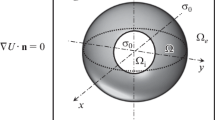Abstract
Optimization problems for a three-dimensional model of acoustic scattering are formulated and studied. These problems arise in designing tools for cloaking material bodies by applying the wave flow method. The cloaking effect is achieved due to an optimal choice of variable parameters of the inhomogeneous isotropic medium occupying the sought shell. The solvability of direct and optimization problems for the acoustic scattering model is proved, and sufficient conditions ensuring the uniqueness and stability of optimal solutions are established.
Similar content being viewed by others
References
L. S. Dolin, “On the possibility of comparing three-dimensional electromagnetic systems with a inhomogeneous anisotropic filling,” Izv. Vyssh. Uch. Zaved. Radiofiz. 4 (4), 964–967 (1961).
J. B. Pendry, D. Shurig, and D. R. Smith, “Controlling electromagnetic fields,” Science 312 (1), 1780–1782 (2006).
U. Leonhardt, “Optical conformal mapping,” Science 312, 1777–1780 (2006).
S. A. Cummer and D. Schurig, “One path to acoustic cloaking,” New J. Phys. 9, 45 (2007).
H. Chen and C. T. Chan, “Acoustic Cloaking in three dimensions using acoustic metamaterials,” Appl. Phys. Lett. 91, 183518 (2007).
S. A. Cummer, B.-I. Popa, D. Schurig, et al., “Scattering theory derivation of a 3D acoustic cloaking shell,” Phys. Rev. Lett. 100, 024301 (2008).
A. N. Norris, “Acoustic cloaking theory,” Proc. R. Soc. London, Ser. A 464, 2411 (2008).
A. Greenleaf, Y. Kurylev, M. Lassas, and G. Uhlmann, “Isotropic transformation optics: Approximate acoustic and quantum cloaking,” New J. Phys. 10, 115024 (2008).
R. Kohn, D. Onofrei, M. Vogelius, and M. Weinstein, “Cloaking via change of variables for the Helmholtz equation,” Commun. Pure Appl. Math. 63, 973–1016 (2010).
G. V. Alekseev and V. G. Romanov, “One class of nonscattering acoustic shells for a model of anisotropic acoustics,” J. Appl. Ind. Math. 6 (1), 1–5 (2011).
H. Nguyen, “Full range scattering estimates and their application to cloaking,” Arch. Ration. Mech. Anal. 203, 769–807 (2012).
H. Liu, “On near-cloak in acoustic scattering,” J. Differ. Equations 254, 1230–1246 (2013).
S. Xu, Y. Wang, B. Zhang, and H. Chen, “Invisibility cloaks from forward design to inverse design,” Sci. China Inf. Sci. 56, 120408 (2013).
B.-I. Popa and S. A. Cummer, “Cloaking with optimized homogeneous anisotropic layers,” Phys. Rev. A 79, 023806 (2009).
Z. Z. Yu, Y. J. Feng, X. F. Xu, J. M. Zhao, and T. Jiang, “Optimized cylindrical invisibility cloak with minimum layers of non-magnetic isotropic material,” J. Phys. D: Appl. Phys. 44, 185102 (2011).
X. H. Wang and E. Semouchkina, “A route for efficient non-resonance cloaking by using multilayer dielectric coating,” Appl. Phys. Lett. 102, 113506 (2013).
G. V. Alekseev, “Control of boundary impedance in two-dimensional material-body cloaking by the wave flow method,” Comput. Math. Math. Phys. 53 (12), 1853–1869 (2013).
G. V. Alekseev, “Cloaking via impedance boundary condition for 2-D Helmholtz equation,” Appl. Anal. 93, 254–268 (2014).
G. V. Alekseev, Problem of Cloaking in Acoustics, Optics, and Heat Transfer (Dal’nauka, Vladivostok, 2016) [in Russian].
D. S. Anikonov, V. G. Nazarov, and I. V. Prokhorov, “Visible and invisible media in tomography,” Dokl. Akad. Nauk 357, 599–603 (1997).
D. Colton and R. Kress, Integral Equation Methods in Scattering Theory (Wiley, New York, 1984; Mir, Moscow, 1987).
A. S. Il’inskii, V. V. Kravtsov, and A. G. Sveshnikov, Mathematical Models of Electrodynamics (Vysshaya Shkola, Moscow, 1991) [in Russian].
M. Cessenat, Mathematical Methods in Electromagnetism: Linear Theory and Applications (World Scientific, Singapore, 1996).
Yu. G. Smirnov, Mathematical Methods for Studying Electrodynamic Problems (Penz. Gos. Univ., Penza, 2009) [in Russian].
D. Colton and R. Kress, Inverse Acoustic and Electromagnetic Scattering Theory (Springer, New York, 2013).
A. N. Bogolyubov, A. L. Delitsyn, and A. G. Sveshnikov, “On the Problem of Excitation of a Waveguide Filled with an Inhomogeneous Medium,” Comput. Math. Math. Phys. 39, 1794–1813 (1999).
A. N. Bogolyubov, A. L. Delitsyn, and A. G. Sveshnikov, “On solvability conditions for the problem of waveguide excitation,” Dokl. Akad. Nauk 370, 453 (2000).
A. Samokhin, Y. Shestopalov, and K. Kobayashi, “Stationary iteration methods for solving 3D electromagnetic scattering problems,” Appl. Math. Comput. 222, 107–122 (2013).
G. V. Alekseev and A. V. Lobanov, “Stability estimates for solutions to inverse optimization problems for the Helmholtz equation,” Sib. Zh. Ind. Mat. 16, 14–25 (2013).
G. V. Alekseev and V. A. Levin, “Optimization method of searching parameters of an inhomogeneous liquid medium in the acoustic cloaking problem,” Dokl. Phys. 59 (2), 89–93 (2014).
G. V. Alekseev, Optimization in Stationary Problems of Heat and Mass Transfer and Magnetohydrodynamics (Nauchnyi Mir, Moscow, 2010) [in Russian].
J. M. Melenk, “Convergence analysis for finite element discretizations of the Helmholtz equation with Dirichlet-to-Neumann boundary conditions,” Math. Comput. 79, 1871–1914 (2010).
A. N. Tikhonov and V. Ya. Arsenin, Solutions of Ill-Posed Problems (Halsted, New York, 1977; Nauka, Moscow, 1986).
A. V. Fursikov, Optimal Control of Distributed Systems: Theory and Applications (Nauchnaya Kniga, Novosibirsk, 1999) [in Russian].
Author information
Authors and Affiliations
Corresponding author
Additional information
Original Russian Text © G.V. Alekseev, A.V. Lobanov, Yu.E. Spivak, 2017, published in Zhurnal Vychislitel’noi Matematiki i Matematicheskoi Fiziki, 2017, Vol. 57, No. 9, pp. 1477–1493.
Rights and permissions
About this article
Cite this article
Alekseev, G.V., Lobanov, A.V. & Spivak, Y.E. Optimization method in problems of acoustic cloaking of material bodies. Comput. Math. and Math. Phys. 57, 1459–1474 (2017). https://doi.org/10.1134/S0965542517090032
Received:
Accepted:
Published:
Issue Date:
DOI: https://doi.org/10.1134/S0965542517090032



